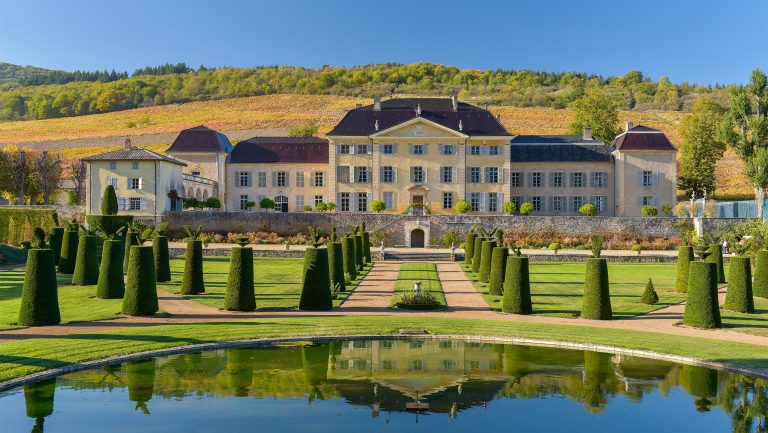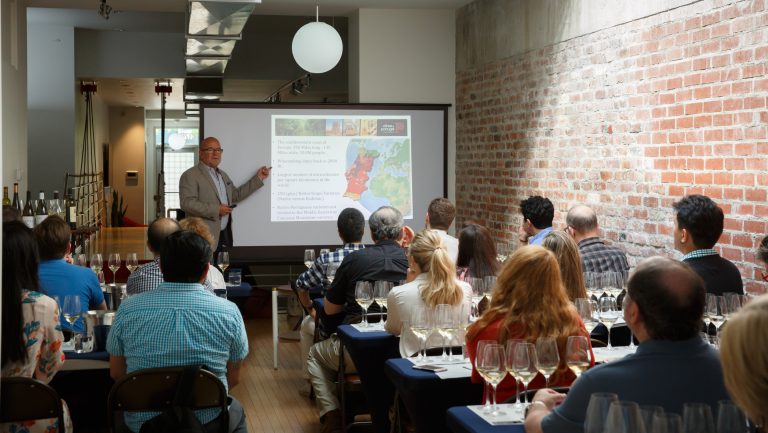This advertising content was produced in collaboration with our partner, Château de La Chaize.
France is covered in historic and illustrious châteaux—Renaissance-era monuments to the glory of great French wine—yet few vinous palaces combine history, artistry, and modernity like Beaujolais stalwart Château de La Chaize.
Walking through the sundial-shaped gardens of the estate, the site’s aristocratic history is impossible to ignore: The towering namesake castle looms before a reflecting pool from which the rolling, nearly 750-acre estate extends—really—as far as the eye can see. Punctuated at intervals by even, orderly plots of grapevines and peaked rooftops, it’s obvious why the French government named the site a historic monument in 1972, and why G6 dignitaries chose to visit La Chaize in 1996: This is a special slice of France.
Yet Château de La Chaize is more than a stone marvel and legacy Beaujolais producer. The Brouilly estate is a driving force behind Beaujolais’ modern renaissance. Under new family ownership for the first time in its 350-year history, the modern Château de La Chaize is an inspiring example of how history and a terroir-focused estate can thrive in the modern era without erasing an ounce of its history.

Don’t miss the latest drinks industry news and insights. Sign up for our award-winning newsletters and get insider intel, resources, and trends delivered to your inbox every week.
Looking Back and Moving Forward
Originally founded in 1676 by the steward of Lyon and expanded until 1811, there’s no shortage of history at Chaize to inspire the Gruy family, who took ownership of Château de La Chaize in 2017. The original estate was designed by the preeminent French architect of the time, Jules Haroudin Mansart, in tandem with famed royal gardener André le Nôtre.
Remarkably, Château de La Chaize never dabbled in Beaujolais Nouveau wines, a trend the Gruy clan is continuing in tandem with their devotion to restoring the estate to its original splendor. And their timing couldn’t be better, as research from Nielsen shows consumers are spending more on Beaujolais than ever before, with average prices up over 5 percent in May 2021 over the previous year, in tandem with increased imports. Cru Beaujolais is continuing to gain traction among consumers in the way that it has among trade—and Château de La Chaize is ready to meet that demand.
“I see myself as a liaison, passing down authenticity from a prestigious past to a bright future,” says head winemaker Boris Gruy, who has guided the grape growing and winemaking at the estate since its acquisition by his family. “I want Château de La Chaize to be heralded, once again, as one of the most beautiful wine-producing estates in France.”
With a clear focus on the estate’s wines, the Gruy clan has masterfully woven modern, precise winemaking capabilities into the estate’s historic footprint. A close look within the historic barrel chai, which is as long as Notre Dame Cathedral and the site of all winemaking, reveals a hidden connection to the estate’s modern cellar and bottling area. Tucked deftly into the hillside adjacent to the historic chai, Château de La Chaize wines can be moved gently and precisely via underground gravity-fed tunnels.
The result is wines that clearly showcase their cru Beaujolais DNA: Vivacious reds that are emblematic of their terroirs in Brouilly, Côte de Brouilly, Morgon, and Fleurie yet precisely tuned for contemporary palates.
The estate’s verdant exteriors likewise conceal the underpinnings of Château de La Chaize’s geothermal energy system, which propels water through the estate’s outbuildings in a 100 percent renewable energy system. Solar panels and self-powered electric vehicles are likewise tucked into the winery, which is on track to function as a completely self-sufficient energy ecosystem. The team is also focused on the preservation of more than 250 hectares of pristine woodland and meadows that surround the estate vineyards, which act as a natural barrier for the vines and contribute to a healthy, balanced ecosystem.
“Climate change has direct consequences on our vines and our wines,” says Gruy of the ambitious plan, which received France’s prestigious HVE environmental certification in 2021. The estate is also in process to receive organic certification.
Doubling Down on Terroir
Situated in the southernmost cru in Beaujolais, Brouilly, the Gruy family’s ambitious goal is centered on elevating not just their own terroir but that of the entire region by leading the charge to develop premier cru appellations within the region’s established villages to submit for INAO approval.
To do so, the team is focused solely on estate holdings of Gamay, which they are elevating with the exacting standards of their Côte d’Or neighbors. By delineating their significant acreage into a dizzying array of lieux-dits and focusing on parcel-based winemaking, Château de La Chaize is embodying the Burgundian approach that’s often talked about yet rarely embraced in practice.
“It is a constant experiment in observation and experimentation that starts to pay off as we see positive evolution in our wines, which tend to be more balanced and precise vintage after vintage,” says Gruy.
The transition to precise, parcel-based winemaking began in tandem with the estate’s transition to organic viticulture. The process, which included significant replanting to support low-intervention agriculture, allowed Gruy and his counterparts to reevaluate their granite terroirs. In doing so, the team unearthed differences within and between the parcels that are so profound Château de La Chaize began bottling several single-site wines.
“We try to work with precision, respect for the vines and the wines as much as possible,” explains Gruy of his motivation to delineate and define the Chaize vineyards. “Gamay Noir is a great translator of its terroir, especially on granite and blue-stone soils, so our wines can mirror the greatest terroirs of Beaujolais.”
In transmitting that terroir, Gruy’s combination of innovation and tradition is as seamless as the winery’s construction, marrying precision with regional winemaking norms, such as aging in large oak foudres rather than barriques.
“We have decided to continue to age our wines in large oak vats, which are perfectly adapted to the Gamay Noir grape,” he explains. “Lots of winegrowers are turning to barrel aging which has a greater impact on the aromatic profile, richness, and complexity of the wine.”
The seamless fusion of Gruy’s gentle yet focused approach in the vineyards and cellars is palpable in the 2019 Château de La Chaize wines currently on the market: Marked by a silken texture and underpinned by classic Brouilly minerality, the 2019 Brouilly marries the Beaujolais’ signature friendliness with the clarity and complexity of an age-worthy red. Their Fleurie similarly transmits its terroir with lacy delicacy accented with vibrant fresh fruit tones.
“My role as the winemaker of a historical estate is to maintain the savoir-faire and heritage which are a part of the culture of Beaujolais,” says Gruy, who was awarded France’s Guide Hachete Winemaker of the Year award in 2021. “It’s crucial to learn from the best of what has been done by our elders, but also to integrate innovations.”
With Gruy at the helm, it remains hard to decide whether Château de La Chaize’s historic palace or holistic modern approach to winemaking is more impressive. Combined, the two offer a refreshing image of what a modern French estate can be, coupling state-of-the-art technology with three centuries of history in the name of truly great wine.

Dispatch
Sign up for our award-winning newsletter
Don’t miss the latest drinks industry news and insights—delivered to your inbox every week.









